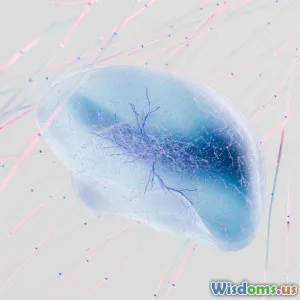
Why Do Naked Mole Rats Feel No Pain A Biologists Fascination
8 min read Explore why naked mole rats feel no pain and uncover the biological marvel capturing scientists' fascination. (0 Reviews)
Why Do Naked Mole Rats Feel No Pain? A Biologist's Fascination
Few creatures in the animal kingdom have mystified scientists quite like the naked mole rat. These small, burrowing rodents, native to East Africa, defy typical mammalian biology by exhibiting an extraordinary trait: they don’t seem to feel pain the way other animals do. This peculiar insensitivity has not only intrigued biologists but also opened new frontiers in understanding pain and potential treatments for human ailments.
Introduction: A Rodent That Defies Pain
Imagine a creature that scurries through underground tunnels, exposed to rough, abrasive environments, yet never flinches from what should be agonizing discomfort. Naked mole rats ( Heterocephalus glaber ) live almost entirely subterranean lives in harsh, low-oxygen conditions, where you'd expect pain to be an ever-present deterrent. However, they exhibit an almost complete lack of sensitivity to acid and chemical irritants, prompting biologists to ask — why?
The answer lies deep within their molecular biology, evolutionary adaptations, and unique physiology. This article unravels the mystery behind the naked mole rat’s pain insensitivity and explores its broader implications.
Understanding Pain: The Biological Basics
Before diving into the naked mole rat’s uniqueness, it helps to understand how pain works in mammals generally. Pain is a vital biological mechanism designed to warn organisms of damage, injury, or excessive stimuli that could threaten survival.
- Nociceptors: Specialized nerve endings detect harmful stimuli like heat, pressure, or chemicals (such as acids).
- Signal Transmission: Once activated, nociceptors send signals through peripheral nerves to the spinal cord and brain.
- Perception: The brain interprets these signals, resulting in the conscious experience of pain.
This system is almost universal in mammals, and its impairment can severely compromise an animal’s ability to survive.
The Naked Mole Rat’s Unusual Pain Insensitivity
Naked mole rats disrupt this narrative radically. Researchers first noticed that despite nerve endings seemingly capable of detecting harmful stimuli, these rodents do not exhibit typical pain behaviors under acidic or noxious conditions.
1. Lack of Sensitivity to Acidic Pain
One of the naked mole rat’s most striking traits is its ability to tolerate extreme environmental acidity. This is due to a mutation leading to the absence of a normally crucial neuropeptide called substance P, which transmits pain signals caused by acidic stimuli. Without this signaling molecule, pain pathways that respond to acid become dormant.
In a landmark study published in Science (2012), researchers demonstrated that compared to mice, naked mole rats exhibited markedly reduced pain responses when exposed to acid. Intriguingly, when naked mole rats were injected with substance P, their pain sensitivity to acid was restored, confirming this mechanism.
2. Unique Sodium Channel Modifications
Beyond substance P, the sodium channels in the nerve cells of naked mole rats have unique mutations. These ion channels play a key role in initiating and propagating nerve signals related to pain. Alterations in these channels reduce the excitability of nociceptors, making the sensory neurons less responsive to painful stimuli, including heat and mechanical pressure.
3. Adaptations to a Hypoxic Environment
Naked mole rats inhabit low oxygen (hypoxic) underground tunnels. Prolonged exposure to such conditions may have favored reduced metabolic sensitivity to protect their neurons from damage due to overstimulation or ischemia-induced pain signals.
Evolutionary Perspective: Why Evolve Pain Insensitivity?
At first glance, lacking the ability to feel pain sounds like a disadvantage. Yet in the ecological niche naked mole rats occupy, this adaption is remarkably advantageous.
- Living in constricted tunnels: Sensory overload from constant abrasion and hypoxic stress could lead to chronic pain, impairing survival.
- Social colonial lifestyle: Naked mole rats live in eusocial colonies with a queen and worker system. An altered pain response might reduce unnecessary stress and aggression, promoting colony stability.
- Longevity and low cancer rate: Naked mole rats are long-lived (up to 30 years) and highly resistant to cancer. Their unique biochemistry including efficient DNA repair may be linked to their unusual nerve physiology, though this remains under investigation.
Implications for Human Medicine
The naked mole rat’s biology shines a new light on potential pain therapies:
- Novel painkillers: Understanding how substance P pathways are altered could inspire new analgesic drugs that target specific pathways without the side effects of opioids.
- Treatment of chronic pain: Patients with conditions like neuropathic pain might benefit from therapies based on mole rat ion channel mutations.
- Disease tolerance: The study of their hypoxia adaptations may yield insight into brain injuries associated with oxygen deprivation in humans.
Quotes from Researchers
Dr. Thomas Park, a pioneer mole rat researcher, remarked: "The naked mole rat rewrites the textbook on how mammals sense pain—illustrating nature’s ability to innovate in the most unexpected ways."
Another expert, Dr. Yenari Wu, commented, "Unlocking pain resistance in these animals could revolutionize how we manage both acute and chronic human pain conditions."
Conclusion: A Tiny Creature with Massive Lessons
The naked mole rat’s inability to feel pain challenges fundamental assumptions about mammalian biology. Far from being a flaw, it is a finely tuned evolutionary adaptation shaped by their unique subterranean environment. For biologists, it is a living experiment in nerve function, genetics, and survival strategy.
What this means for humans is equally profound—a beacon guiding new strategies for pain treatment, improved understanding of neurobiology, and even aging and cancer resistance mechanisms.
The humble naked mole rat reminds us that nature’s oddities often hold keys to solving some of our most pressing medical challenges. As scientists continue to study this extraordinary animal, the promise of translating its pain-free secret into human benefit becomes ever more exciting.
References:
- Park, T. J., et al. (2008). "Somatosensory organization and behavior in naked mole-rats: cold sensitivity and tissue-specific acid insensitivity." Science, 322(5905), 1557–1561.
- Omerbasic, D., et al. (2012). "Hypofunctional TRPV1 alters pain sensation and body temperature regulation in naked mole-rats." Science, 335(6076), 544–547.
- Lewin, G. R., & Moshourab, R. A. (2016). "Mechanisms of neuropathic pain." Neuroscience Letters, 17(8), 831–839.
Rate the Post
User Reviews
Popular Posts



















